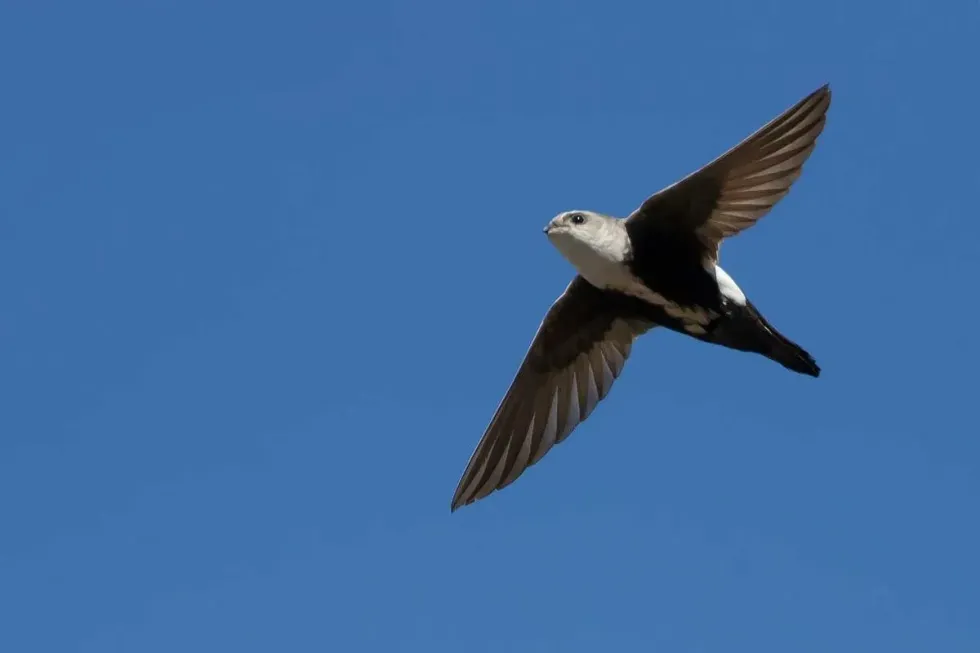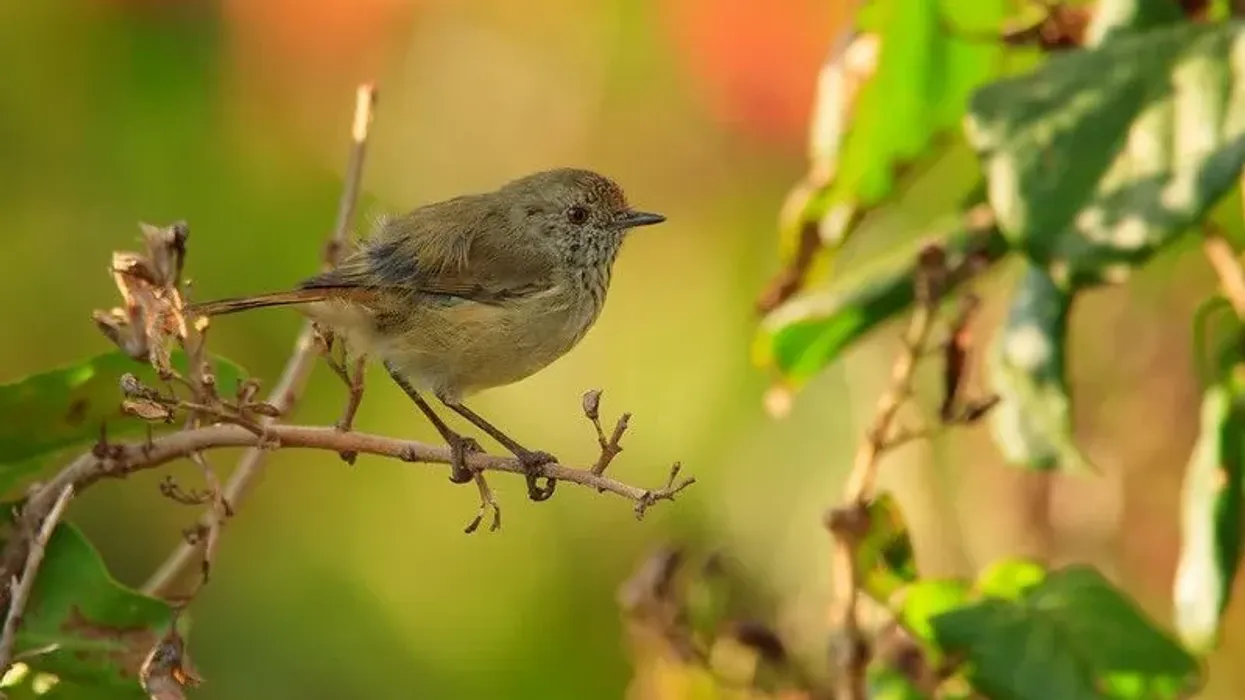White-throated swifts (Aeronautes saxatalis) belong to the Apodidae family and are mostly found in North America.
The range of these birds includes coastal and south California, southern region or parts of Arizona, the southern part of New Mexico, western Texas, the central region of Mexico, parts or regions of British Columbia, and in or around Sierra Madre Occidental mountain range.
The habitat of these birds includes rocky cliffs, forests, canyons, sea cliffs, meadows, crevices. They are also found near lakes and ponds.
They are also known to inhabit human-made establishments like bridges, highway overpasses, buildings, and quarries. These birds are known to engage in courtship displays and are known to mate in flight or in the air.
The nests are built near or in, or nest sites include crevices of cliffs that are narrow. The nests of these birds are shallow and made with grasses and feathers.
3-6 white-colored eggs are laid by the female, and they are incubated for about 20-27 days, and the incubation is done by both the parents. When about six weeks old, the first flight of the chick or the young one happens.
Eating or foraging also happens during flight or in the air, and they feed on flying insects like beetles and wasps. The white-throated swifts are long and slender, and the wings are also narrow and long and have a basic black and white plumage and a white throat.
These are quite social birds in terms of behavior. The conservation status of these white-throated swifts is known to be Least Concern.
It is interesting to know about white-throated swifts and if you are interested, read about some similar birds or species with our mountain bluebird facts and snowy egret facts too.
White-Throated Swift Interesting Facts
What type of animal is a white-throated swift?
The white-throated swift (Aeronautes saxatalis) is a species of bird. They are known for their visibly white throat, black wings and are mainly found in North America.
What class of animal does a white-throated swift belong to?
The white-throated swift (Aeronautes saxatalis) belongs to the class Aves of birds.
How many white-throated swifts are there in the world?
The population of the white-throated swift (Aeronautes saxatalis) is approximately 3.2 million in the world, mostly found in North America.
Where does a white-throated swift live?
The population of this species is distributed in the range map that includes parts of coastal and south California, southern region or parts of Arizona, the southern part of New Mexico, western Texas, the central region of Mexico, parts or regions of British Columbia, and in or around Sierra Madre Occidental mountain range.
What is a white-throated swift's habitat?
The habitat of the white-throated swift (Aeronautes saxatalis) primarily consists of hilly and mountainous regions. It is found in arid regions and is also found near lakes and also found in sea cliffs.
It is known to forage in or above forests, cliffs, canyons, meadows, and pinnacles. Nesting takes place in crevices of cliffs and also human-made establishments like bridges, highway overpasses, buildings, and quarries. Nesting happens or takes place at low elevations.
Who does white-throated swift live with?
These North-American birds are known to be social ones by behavior and can be seen or spotted in groups during foraging and roosting.
How long does a white-throated swift live?
The exact lifespan of this bird is unknown, but swifts are known to live for about 10-20 years.
How do they reproduce?
Before breeding, there are courtship rituals that take place, and this includes aerial displays. The nesting and breeding take place mostly in May, and in April in southern areas.
Mating or breeding is also known to happen during the flight. The nest site of this bird is known to be crevices of cliffs that are narrow.
It could also be in crevices of buildings, and the same nests are known to be used for many years. The nest is known to be shallow and is saucer-shaped, which is made with weed, feathers, and grasses.
Around 3-6 eggs are laid by the female. These eggs are white in color and can become spotted in the nest.
Incubation takes place for about 20-27 days and is done by both the parents, and the young ones are also fed by both males and females. When about six weeks old, the first flight of the chick happens.
What is their conservation status?
These North-American birds have been listed as Least Concern for their conservation status.
White-Throated Swift Fun Facts
What do white-throated swift look like?
This bird is known to be a medium-sized bird with a slender and long body. The wings are also narrow and long and are curved like a dagger or a scimitar.
The plumage of this bird is known to be black and white, and the wings and back are known to be black or brownish-black in color. The chin, throat, chest, breast, and belly are white in color.
There is not much difference between a male and a female in terms of appearance. The young ones look similar to adults, but the head and neck feathers are a bit paler or duller as compared to an adult.
How cute are they?
These North-American birds are considered cute.
How do they communicate?
Not much information is available regarding the communication of this species. Still, it is believed that it produces sounds, songs, or calls of different types in order to communicate with each other.
How big is a white-throated swift?
This species can be smaller or similar in size to similar species like common swift and larger than a chimney swift. The length of this bird can range from 5.9-7 in (150-180 mm).
How fast can a white-throated swift fly?
The exact speed is unknown, but it is known to be a fast flyer. The wingspan of this species is around 14 in (355 mm).
How much does a white-throated swift weigh?
The weight of this species ranges from 0.06-0.07 lb (0.028-0.036 kg).
What are the male and female names of the species?
There is no specific name for a male and female of the species.
What would you call a baby white-throated swift?
There is no particular name for a baby white-throated swift, but it is referred to as chick, young one, or juvenile in general.
What do they eat?
These North-American birds are known to feed on flying insects primarily. The flying insects include beetles, flies, wasps, true bugs.
They are also known to also feed on winged adult ants. The water requirements of these birds are fulfilled by their diet of flying insects and are also known to be around the surface or edges of the ponds or lakes to drink. The foraging takes place during flight or in the air.
Are they dangerous?
Not much information is available about these birds being dangerous or not. They are generally harmless and do not interfere with humans.
Would they make a good pet?
It has been recorded that the swift has not been domesticated by humans in any form. As a bird, it is best to let them live in their natural habitat.
Did you know...
These birds are known to follow farm machinery to prey on flying insects. This kind of behavior is widespread in swallows and gulls.
Predators of this bird include prairie falcons, peregrine falcons, and American kestrels.
These white-throated swifts are known to roost in groups of hundred birds which takes place in niches or cracks of cliffs.
The oldest record of this species is around 10 years old, and it was recaptured and re-released in California in 2006.
There have been 19 genera and a total of 92 swifts have been recognized or categorized.
Most similar species of swifts are known to inhabit canyons, meadows, and cliffs.
Do swifts ever sleep?
Except during nesting, these birds are always flying and are known to sleep for a very short span on the wing or when in flight. Foraging is also known to happen during the flight.
Do swifts ever stop flying?
The adult birds of this species are known to be flying all time except nesting. They are known to eat, sleep and mate during flight.
Here at Kidadl, we have carefully created lots of interesting family-friendly animal facts for everyone to discover! For more relatable content, check out these American redstart facts and peahen facts pages.
You can even occupy yourself at home by coloring in one of our free printable white-throated swift coloring pages.










